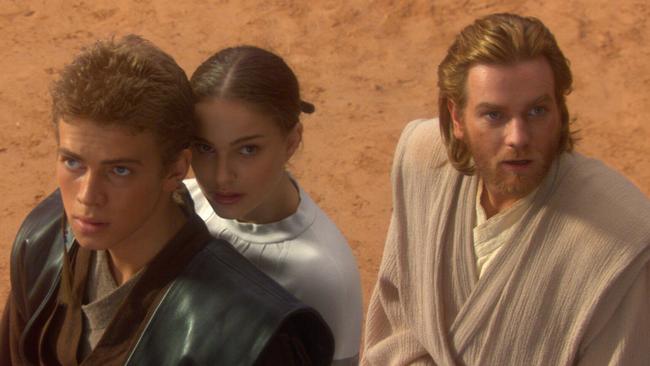Star Wars: Attack of the Clones review 2002
This review of the fifth Star Wars movie, Attack of the Clones, ran in The Weekend Australian on Saturday May 18, 2002.

This review of the fifth Star Wars movie, Attack of the Clones, ran in The Weekend Australian on Saturday May 18, 2002.
Lucas’s star saga back on track
By Evan Williams
THE most difficult thing for reviewers of a new Star Wars film is to avoid using the phrase “The Force is with us’’. Or any play on the words long ago and far, far away. The last episode, The Phantom Menace, wasn’t all that long ago by George Lucas’s standards - only three years - and the new one, Star Wars: Episode II - Attack of the Clones, is set a mere 10 years later. Ten years! What sort of timeless, intergalactic saga is measured in decades? Centuries, millennia would be more like it. At least it makes it easier for Anakin Skywalker, nine years old in the previous episode, to emerge credibly as a spunky young heart-throb in the new film and be smitten by Padme Amidala, played by the beautiful (and now equally grown-up) Natalie Portman. Star Wars time may flow in eons but audiences are still measured in teens.
As it happens, I liked this Star Wars more than the others - certainly more than the last - and not just because of the much-touted love story. A bit of galactic romance was overdue. Memories of Han Solo and Princess Leia flirting in the original film - henceforth to be known, incidentally, on the orders of George himself, as Episode IV: A New Hope - had faded long, long ago, and something was needed to give a warm emotional charge to the battles and funny costumes. But Attack of the Clones seems to me better for all sorts of reasons: it’s richer, more colourful, more inventive - and yes, plain funnier - and a clone is the last thing I’d call it. If it weren’t for the fact that the term “clone wars’’ has a certain textual legitimacy - having been used in the first film, when the term must have been freshly minted - you’d wonder why the word was chosen for the title.
But some things about Star Wars will always feel clone-like, including the impenetrability of the story. I’ve never really followed it, and am now resigned to the fact that it doesn’t matter. You can take it from me that the Republic continues to be mired in chaos; that the Trade Federation - not to be confused with the other Federation in Star Trek Insurrection - is still at war with Amidala’s home planet Naboo. A separatist movement, not to be confused with the Trade Federation, poses new threats to the galaxy. Anakin Skywalker, the Jedi apprentice of Obi-Wan Kenobi, destined to turn into Darth Vader, is again the hero of the hour. Anakin and Obi-Wan are dispatched to protect Amidala, former queen of Naboo, now a senator, who is targeted for assassination (bombs, deadly bugs and other nasties reminiscent of a Bond movie).
Being a prequel, Attack of the Clones has the great advantage that no one will be surprised when some characters look younger than they did in earlier instalments. Ewan McGregor looks so relaxed and comfortable as Obi-Wan that my first impression was not how much younger he looks than Alec Guinness but how much older he looks than the hero of Moulin Rouge.
It’s best to sit back and relish the gadgets. Why, you wonder, do the costumes look so primitive (Portman wears something like a medieval tapestry) when technology is otherwise so advanced? Why do weapons, in an era of anti-matter reactors and neutron transmitters, resemble guns and swords? Why does a gravity-defying chariot, in a prelude to the great Gladiator-style climax, have to be drawn by a beast of burden? To ask such questions is, of course, no more sensible than to ask why wars are still fought with armies - legions of clone troopers confronting vast columns of battle droids - when whole planets, you’d suppose, could be wiped out with a single zap of a laser.
The Phantom Menace (1999) looked so tired and mechanical that one rarely had a sense of awe and wonder; the razzle-dazzle action, the smash-and-grab technical high jinks, seemed to exist in a vacuum. In Attack of the Clones the love story, though played self-consciously with moonlit kisses and some romping in sunny meadows beside digital waterfalls, gives a binding thread to the narrative; and Hayden Christensen, as Anakin, has the right eerie charm with a hint of the Dark Side to emerge in later instalments. The many splendid sets include an infernal droid production line and dazzling, head-numbing evocations of the planet-sized megapolis of Corusant.
Being in the epic fantasy business, inventing whole new mythologies, is no easy thing. You’re competing with Wagner, Shakespeare, Tolkien, C.S. Lewis, lesser practitioners such as Frank Herbert and J.K. Rowling. It’s by no means certain that the Star Wars movies are market leaders. Nothing in Attack of the Clones matches, for me, the dense visual magic of The Fellowship of the Ring. But this is still one of Lucas’s best. It would be nice to think that has something to do with the studios in Sydney, the new digital cameras, the presence of Jack Thompson and other Aussies in smaller roles, but it’s really much simpler than that: the film is touching, spectacular and surprisingly coherent. It also has something the others lacked entirely: old-fashioned charm. This time, The Force is with us.
Three stars


